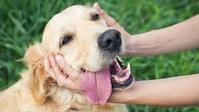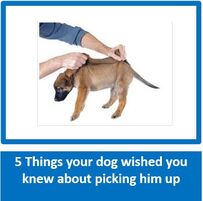
Please visit and LIKE / FOLLOW our Facebook Page and share with family, friends and on your own Facebook page, and ask them to share further – it is only by working together and sharing knowledge and education that we can improve the lives of dogs and assist owners. We do not inundate you with posts – an average of 5 per week, plus one Tip of the Week, and the odd informative post. Thank You!

Praise Him, Praise Him - However, Praise Must Be Used Correctly
(Courtesy of Julie Tobiansky – Dog Obedience Trainer - Cape Province Dog Club)
www.capeprovincedogclub.co.za
(Courtesy of Julie Tobiansky – Dog Obedience Trainer - Cape Province Dog Club)
www.capeprovincedogclub.co.za
.
Praise is one of the most useful training aids we dog handlers have at our disposal. Used correctly, it can turn a bad dog into a good dog and a good dog into a great dog. Used incorrectly, it can turn a good dog into a nervous, insecure and disobedient dog.
A dog who is talked to and fussed constantly is not going to really work for praise In fact all the fussing is likely to make him over dependent and neurotic.
Before we look at how we can make praise work for us, we need to make sure that the praise is of value to the dog :
Praise is one the most useful training aids in your tool box. Make sure you get the most out of it.
A dog who is talked to and fussed constantly is not going to really work for praise In fact all the fussing is likely to make him over dependent and neurotic.
Before we look at how we can make praise work for us, we need to make sure that the praise is of value to the dog :
- Train yourself to use a sing-song high pitched tone for verbal praise. Practice on your dog until you find the level that makes his tail wag. For some a quick, ”Good Boy” will do the trick but for others some cheerleading “WOW!!! That was GREAT!” will be needed. Tone down your usual chatter at home to make the praise more valuable.
- To make praise even more effective, you can couple it with a reward. Some dogs will not do a thing for profuse praise even if you stand on your head. Tiny tasty treats, a chance to tug on a toy or chase a ball are all good rewards to couple with verbal praise.
- Physical praise needs to be something your dog really enjoys. Some love a thump on the side, (my dogs do) while others will wonder what they have done wrong if you try that. Some like a scratch behind their ears, on their chest or the base of the tail. Most dogs hate being patted on the head, so try patting him on the side or neck instead. You’ll have to do some experimenting. It is no use offering a form of praise which makes your dog shut down. If his tail or his bum wags, his mouth falls open and he looks up at you, you are probably on the right track. If he licks his lips, yawns or looks away with his ears flat back, you will need to rethink your approach as he showing signs of stress.
- When trying to teach your dog something, timing of the praise is the key to it’s effectiveness. A while back I was watching a competition handler practicing her retrieve with her dog. She set the dog up, told him to wait and threw the dumbbell. The dog waited until she gave the Fetch command. He ran out enthusiastically and as he was about to pick up the dumbbell, the handler called out, ”Good Boy!” As the dog heard this, he stopped in his tracks and ran back to her happily forgetting about the dumbbell. The handler was most frustrated and sent the dog to fetch the dumbbell again with the same result. As I watched, this happened again and again. The dog seemed to know what he was meant to do but would stop just short of picking up the dumbbell. After a while, he stood confused over the dumbbell looking at his handler.
So what went wrong? The dog was doing exactly what his handler had trained him to do. As far as he could see, the exercise consisted of sitting and waiting while his handler threw the dumbbell, then on command, running out to it and then running back to receive his praise. Praising him as he got to the dumbbell made him think that not picking it up was what his handler wanted instead of picking it up. To fix this, all the handler needed to do was delay the praise until he had the dumbbell in his mouth and was returning to her. - Another example of the importance of timing your praise correctly is when working with a dog who will not walk on the lead at all or one who lags behind in heelwork. Most handlers will find themselves coaxing and praising the dog to make him move or catch up. By doing this, we are praising not walking or lagging instead of walking next to us. Whether you use correction or luring, timing the praise for when the dog is doing what you do want i.e. walking next to you, will have more effect than praising him for the exact behaviour you are trying to fix. With enough ill-timed praise, you can train your dog to lag on the lead in no time at all.
- Praise can also be the cause of stress to your dog. Many handlers make the mistake of trying to calm a nervous dog with soothing words. To the dog, all he hears is praise for his nervous behaviour which makes him more nervous. Timing the praise for the moments when he forgets about his fear and is doing something else like sitting ands watching you would be more effective.
- I also see embarrassed handlers holding their dogs mouth shut when the dog barks or lunges, all the while telling the dog, “It’s okay, it’s okay”. It is NOT okay to bark and lunge, no matter what the motive, (even fear) and the hands around the jaws feel pretty much like praise too. I see this often at the vet.
With four dogs and three cats, I am a “frequent shopper” at my vet. As a result, I get to spend a lot of time observing dog owners with their nervous pets. Almost all, okay, maybe not almost all, in fact ALL owners I see, in an attempt to calm their dogs, praise them for their fearful behaviour i.e. pulling on the lead to get out the door, jumping up, barking, growling, lunging etc. After a couple of these kind of visits to the vet, the dog will learn that this is the way to behave at the vet. ”I don’t understand it!”, I hear them say, “He never was this bad before”. I’m not surprised, I think to myself, they’ve taught him exactly how to behave and he’s getting better at it!” They would help their dogs far more by ignoring the performance and getting their dog to do something else, like sit or lie down and then pile on the praise and treats for good behaviour.
- While out walking or running with my dogs I often have dogs on lead throw themselves at me growling and lunging. Most of these dogs are small and have an owner at the end of the lead, praising away in a soothing voice. “No boy”, they coo, “Naughty Boy – It’s okay.” What do you mean it’s okay to bark and lunge, that’s how little dogs become lunch. I shake my head to myself – trying to suggest that they try a different approach usually results in a rude response. “Walk on the other side of the road!” they shout, You are upsetting my dog” while my dogs look straight ahead intent on their run or walk. So many dogs who perform on the lead when they see another dog could be helped with some distraction and some well timed praise – for not barking and lunging. So there you have it.
Praise is one the most useful training aids in your tool box. Make sure you get the most out of it.




